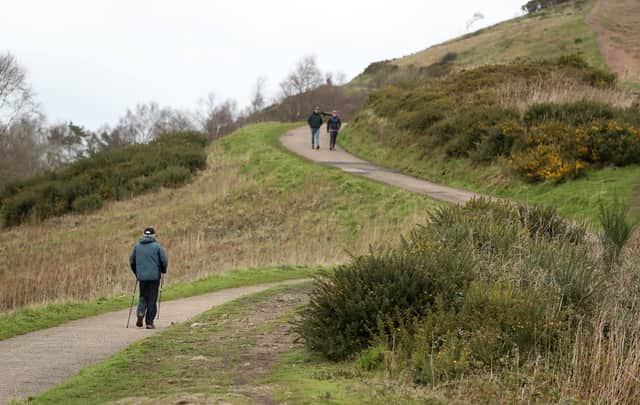Walking - how good is it for health and how many steps should you be getting in per day?
and live on Freeview channel 276
One of the greatest advantages of walking, as an exercise, is its accessibility and affordability. It requires no special equipment or memberships and can be done almost anywhere. We can walk alone, with friends, family, or in walking groups which has the additional advantages of social interaction and emotional support.
Regular walking is one of the healthiest lifestyle strategies which can extend fruitful longevity for several fundamental reasons:
Advertisement
Hide AdAdvertisement
Hide AdCardiovascular Health: Walking reduces the risk of heart disease and stroke by helping to control blood pressure, lower cholesterol and improve circulation to the heart and brain.
Cancer: The protective effect of exercise include reducing chronic inflammation in the body, enhances the formation of antioxidant enzymes that protect our DNA damage, improving gut health, improving vitamin D levels and strengthening the immune system so it can recognise and kill emerging cancer cells.
Weight Management and Diabetes: Walking helps burn calories and maintain a healthy weight especially when combined with a balanced diet. It helps to improving the muscle-to-fat ratio which lowers the risk of insulin resistance leading to diabetes.
Strengthens Muscles, Joints and Bones: Walking engages various muscle groups, including the legs, core, and back improving balance and reducing the risk of falls. Studies show it protect joints from arthritis especially if combined with stretching. It also helps improve bone density, reducing the risk of osteoporosis.
Advertisement
Hide AdAdvertisement
Hide AdMental Well-being and Cognitive Function: Walking boosts mood, and reduces anxiety and depression as it promotes the release of endorphins, also known as "feel-good" hormones. In the longer term it helps maintain cognitive function and avoid dementia.


Improved Sleep: Regular physical activity can improve sleep quality especially walking outside in the morning which enhances circadian rhythm which helps regulate the sleep-wake cycle and promotes deeper, more restful sleep.
Enhanced Immune Function: Moderate exercise, strengthens the immune system, reducing the risk of infection. A more efficient immune system is able to detect and kill early cancer cells and is less likely to over react to elements in food or the atmosphere causing allergies.
How much walking do we need to do?
Many of us walk as part of our routine daily activities which can be bolstered by walking to work, getting off the bus one stop earlier and taking the stairs rather than the escalators.
Advertisement
Hide AdAdvertisement
Hide AdMost studies show that around 2-3 hours of exercise is linked with a 30% lower risk of cancer and other diseases but keeping track on the amount and intensity of exercise can be difficult. Instead, there is an increasing trend to measure the amount of walking via a pedometer with 10,000 steps touted as the ideal daily goal.
Although this target is relatively easily achievable, its origins have not been based on exact science. The concept was instigated by a marketing team in Japan in the 1960s which promoted a pedometer called "Manpo-kei," roughly translated to "10,000 steps meter".
Since then, numerous exercise scientists, like myself, have designed studies to discover the optimal duration, intensity and type of walking to achieve the best benefits. In a nutshell, this is what the evidence shows:
Walking opposed to sitting: A number of studies have shown that prolonged sitting is particularly harmful but a study found that taking a break from sitting for just 5 minutes every 30 mins mitigated the extra risks. Another American study showed that people who did 30 minutes of light-intensity walking per day, if swapped for sitting, had a 20% lower risk of death. More walking, however, does give better results. The same study showed that those who swapped 30 minutes of sitting for 30 minutes of moderate to vigorous physical activity per day had an even greater (35%) reduction in risk of death from any cause.
Advertisement
Hide AdAdvertisement
Hide AdWalking pace: The importance of pace and intensity of walking was confirmed in a study of overweight walkers who only saw weight loss if 3,500 of the 10,000 steps a day were at a moderate-to-vigorous pace. A further study found that men walking more than three hours a week correlated with lower prostate cancer death risk but only if they tended to walk at more than 3mph.
In conclusion, all trials show that any amount of walking is beneficial especially if it helps to avoid sitting. The earlier you start in life and the better and combining walking with other healthy lifestyle habits gives even greater protection as you get older.
Ultimately, the most important thing is to find a step goal that is achievable and sustainable for you and then do this regularly. If you're not currently active, start by gradually increasing your daily step count and aim to incorporate more movement into your routine over time. Listen to your body and adjust your goals based on your progress and any specific health considerations you may have.
Comment Guidelines
National World encourages reader discussion on our stories. User feedback, insights and back-and-forth exchanges add a rich layer of context to reporting. Please review our Community Guidelines before commenting.
